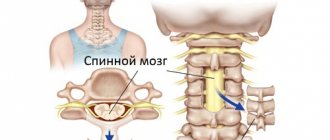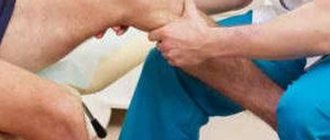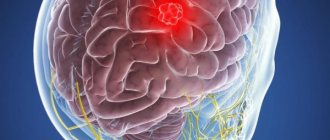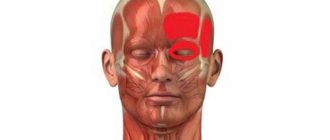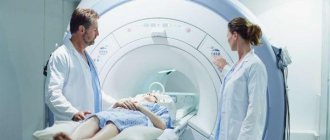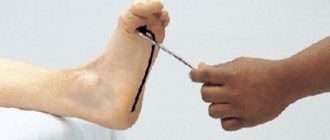Description
Lasegue's symptom is a common phenomenon in neurology, which is classified as tension symptoms. It occurs with pathologies of the femoral nerve and its roots. Typically, such a deviation develops against the background of sprain, inflammation or compression, but it can also be caused by pathologies of muscles and ligaments.
There are several degrees of severity of Lasegue's symptom, which are determined by the angle of leg elevation before the onset of painful sensations:
- First. It is diagnosed if a person experiences severe pain when lifting their leg at an angle of up to 60 degrees.
- Second. It is diagnosed if pain appears in a person even when raising the leg at an angle of up to 45 degrees. As a rule, with this position of the limb, the patient experiences increased muscle tension.
- Third. This degree is determined in those patients who complain of severe pain even when raising their legs at an angle of 15 to 30 degrees. At the same time, they experience accompanying symptoms, including strong muscle contractions throughout the body, muscle tremors, and profuse sweating.
A person’s development of varying degrees of symptom severity depends on various factors, including the causes of pathology, the degree of damage to nerve endings, personal sensitivity to pain, and much more.
Test method
Only a doctor can evaluate Lasègue's symptoms.
Self-testing may not be reliable. To identify this symptom, the patient lies on his back on a couch with his legs extended. The doctor slowly and evenly lifts his straightened leg up. At the same time, the palm of the second hand gently holds the knee, preventing it from bending. You should not put your hands or a cushion under your lower back, and you should not raise your head.
The leg is raised to the height where pain or discomfort begins to be felt in the buttock and along the back of the thigh. The angle of elevation of the leg is measured approximately. This is the first phase of testing the Lasègue symptom. Normally, the entire range of motion should be painless.
In the second phase, the raised leg is gently bent at the knee joint. When pain in the hip disappears, a conclusion is made about a neurogenic cause and osteoarticular pathology of the extremities is excluded.
In the third phase, the leg straightens again, which leads to renewed pain.
The symptom is considered positive if in the first and third phases pain appears on the back of the thigh, and in the second phase it goes away.
The result is false positive if pain occurs only in the lumbosacral region or it is recorded when raising the leg only above 60º.
There is a crossed Lasegue sign, when pain occurs on the affected side when lifting the other leg.
Carrying out the test
In order to evaluate the symptom of Lasègue tension, a special test is used:
- The patient is placed on the couch. They suggest raising one leg until pain appears in the hip area. The movement should be smooth, without jerking. You should lift the limb before the first pain occurs; when it appears, you should stop immediately. If the patient cannot lift his leg on his own, the doctor does it for him.
- The doctor bends the raised limb at the knee. In this case, the person should experience complete relief from painful sensations.
- After this, the patient needs to re-extend the leg without lowering it onto the couch. The pain should return.
- To confirm the test, the leg is raised to its maximum and then sharply bent at the ankle. If the test is positive, the pain should spread to the entire limb.
Lasègue syndrome - what is it?
Pain in the lumbar region is a fairly common occurrence. It can be caused by quite a variety of conditions. Pain in the lumbar region is recorded in the following pathologies:
- vertebrogenic and discogenic lesions of nerve roots;
- renal colic;
- pancreatic diseases;
- pathological changes in vertebral bone tissue.
The symptoms described by various authors, indicating pathology of the spinal disc segment, help to establish the cause of the pain syndrome, diagnose damage to the nerve roots and clarify the severity of the disease.
The most frequently studied phenomenon, which has diagnostic significance and also plays a role in determining the patient’s ability to work, is Lasegue’s symptom.
What it is
Lasègue's symptom in neurology is one of the most famous and most frequently tested signs of damage to the nerve trunks during an exacerbation of spinal osteochondrosis.
A positive Lasègue symptom is indicated when pain occurs in the lumbar region and along the trunk of the sciatic nerve in a patient lying on his back while flexing the hip.
How is Lasegue's symptom caused?
The symptom manifests itself when the lower leg is extended in a patient lying on his back with the hip flexed. The examination should be carried out carefully, without making sudden movements, since pain with a positive Lasègue symptom can be of high intensity.
Lasègue's symptom is positive if pain occurs in the lumbar region, along the back of the thigh and lower leg of the corresponding side. Soreness is usually localized on the side of the affected nerve root.
For example, Lasegue's sign on the right is caused by flexion of the right leg.
- The first phase of Lasegue's symptom: the occurrence or appearance of pain in a patient lying on his back when trying to bend or flex an extended leg at the hip joint.
- The second phase of Lasegue's symptom: if you subsequently bend the leg at the knee without straightening the hip joint, then the pain syndrome either disappears or its intensity sharply decreases.
An important point: it is not allowed to cause the Lasegue tension symptom after the use of anesthesia, since the protective pain reflex in such conditions is significantly reduced; manipulation in this case can lead to tearing of axons and cause motor disorders (up to paresis).
False-positive Lasegue symptom
Normally, people with reduced flexibility, as well as those leading a sedentary lifestyle, often experience pain in the back of the thigh when flexing the hip in a supine position. It is caused by stretching of the muscles of the posterior thigh. This is a false-positive Lasegue symptom, which is not a sign of root pathology.
Interpretation of Lasegue's symptom
In the presence of a pathological process localized in the area of the nerve root, pain may appear when the hip is flexed at different angles (10, 15, 20, 30 degrees). The level at which Lasegue's symptom occurs allows us to judge the severity of the patient's condition and is of great importance for diagnosing the stage of the disease.
In order to track the dynamics of the clinical manifestations of a radicular lesion, it is advisable, when recording the examination results, to indicate the approximate angle at which the patient experiences pain (an example of such a recording: Lasegue’s symptom on the right is positive, 30 degrees).
This will make it possible in the future, during repeated examinations, to compare the current result with the previous one and, based on the comparison results, make a judgment about the dynamics of the patient’s condition.
In particular, an increase in the angle between the plane on which the patient lies and his thigh will indicate a gradual improvement in the patient’s condition.
When does a positive Lasègue symptom occur?
In neurology, this phenomenon belongs to the group of so-called tension symptoms; from the name it is clear that the formation of this diagnostic sign is associated with tension and tension of the nerve trunk.
- The most common case when a positive Lasègue symptom is observed is with osteochondrosis. Inflammation in the area of the nerve root leads to its compression and tension. Other symptoms of this group (Nery, Bekhterev) will also be positive.
- Acute discogenic lumbodynia. This condition occurs when the fibrous ring is torn, leading to protrusion of the intervertebral disc in the spinal disc segment. The cause of such a violation may be awkward movement in the lumbar spine, sudden lifting of weight. Clinically, acute discogenic lumbodynia is manifested by sharp pain in the lumbar region, often causing the patient to “freeze” in the position in which the pain syndrome found him. The duration of a painful attack is from half an hour to several hours. When diagnosing, an important role is played by the symptoms of Matskevich and Lasègue, the “board” symptom (impossibility of flexion in the lumbar region).
- Subacute discogenic lumbodynia. The reason is prolonged physical activity in a position that is uncomfortable for the patient (often in a bent state). Unlike the acute condition, subacute lumbodynia is characterized by a delayed development of pain.
Other diagnostic signs accompanying Lasegue's symptom
- Neri - the occurrence of pain in the lumbar region when the head is flexed.
- Matskevich's symptom is pain in the groin area and the anterior surface of the thigh when the patient bends the lower leg while lying on his stomach.
- Dejerine's symptom is increased pain when coughing or sneezing.
- Bekhterev's symptom (in a number of sources referred to as Lasegue's cross symptom) - when a lying patient sits down, his leg bends at the knee joint on the side of the nerve root lesion. If you straighten this leg, the healthy one will bend. In cases where a positive Lasègue symptom is recorded, ankylosing spondylitis' symptom is usually also positive.
- Lerrey's phenomenon - a pronounced increase in pain in the lumbar region in the event of a sharp transition from a lying position to a sitting position - is almost always a symptom accompanying the Lasègue sign.
Tactics for identifying a positive Lasègue phenomenon
The symptom indicates an acute course of the disease. A patient whose examination reveals this sign is disabled (for at least 10 days).
- The first step is to relieve pain (the use of NSAIDs is optimal; in case of severe pain, drug blockades can be used).
- The patient must be provided with bed rest for the duration of the acute pain syndrome (this is especially important in case of violations of the integrity of the fibrous ring).
- An integrated approach is required: the treatment regimen includes NSAIDs, muscle relaxants, physiotherapy, and, as the exacerbation progresses, exercise therapy.
- To avoid relapses, a patient with discogenic disorders may be advised to wear a lumbosacral corset in situations involving stress on the lumbar spine.
Source:
Causes of Lasegue syndrome in diseases of the musculoskeletal system
In neurology, it can sometimes be difficult to make an accurate diagnosis. Mainly because it is difficult for patients to evaluate their feelings in an objective manner. When the patient constantly suffers from pain, later he is no longer able to interpret it correctly.
It is possible to identify an objective picture of neurological problems using various techniques. Doctors have a variety of tests and tension tests at their disposal.
A positive Lasègue reaction can be caused by a variety of pathologies of the musculoskeletal system.
What is Lasègue syndrome?
This syndrome was discovered by physician Lasegue from France in the 19th century and bears his name. As a result of experiments, it was discovered that some patients experience sharp pain if, while lying on their back, they lift their straightened leg up. If you lower or bend the knee, the pain suddenly goes away.
Normally, the process of stretching the spinal nerves is completely physiological. It should happen easily, without overstrain, the root should slide along the intervertebral foramen without compression. Normally, nerve fibers should move freely and can stretch up to one and a half centimeters, but in many diseases, nerve fibers cannot lengthen normally.
When lifting a limb with the knee straightened, a tension force of 3 kilograms is applied to the nerve. Therefore, if there is possible infringement or shortening of the root, a sharp lifting of the limb can lead to a tear. The result can be paralysis. Therefore, the test must be done extremely carefully. The test for Lasègue syndrome is carried out carefully, and if pain occurs, it is stopped immediately.
Note! The tension test cannot be performed if there is no pain reflex (under anesthesia).
Reasons for appearance
The sciatic nerve is the largest of all in the human body; it is formed by nerve fibers coming from the spinal cord in the sacral and lumbar region. Responsible for the work of the muscles of the buttocks, legs, and thighs. If the nerve fibers are too stretched or pinched, sharp pain appears when lifting a straightened leg. If a person is relaxed, pain is not observed.
The manifestation of a positive symptom occurs in various diseases of the spine, accompanied by muscle spasms. Causes: degenerative changes in the tissues of the spinal cord, osteochondrosis, radiculitis, inflammation of the nerve itself. The cause may be in the hip joint itself. Sometimes the symptom occurs when the paravertebral muscles are tense.
Source: https://mpdoctor.ru/sindromy/sindrom-lasega-chto-eto-takoe.html
Interpretation of results
A positive test can be recognized if the patient experiences acute persistent pain in the hip area when raising the leg to 60 degrees and pain relief when bending the knee. Such symptoms indicate damage to the sciatic nerve.
In older patients, the test is considered false positive if pain is associated with decreased muscle activity. The test is considered negative if the person does not experience pain when bending the limb at the knee.
There is also a cross Lasegue symptom. It is diagnosed if the patient, when lifting his healthy leg, experiences pain on the side of the hip of the diseased limb.
Causes of the syndrome
The main reason for a positive result when testing for Lasegue's sign is a herniated disc. The mechanism of occurrence of the symptom is due to the fact that the tissues supporting the intervertebral disc in their physiological position are damaged, stretched, and the disc can shift towards the spinal canal.
In the canal, the disc can put pressure on the roots of the sciatic nerve; in a relaxed state, the patient does not experience pain, but when tensioned, the nerve must go around the body of the intervertebral disc, this forces it to stretch to a greater length, but it is not capable of this. In this case, painful sensations occur in the lumbar region. Detection of such a symptom requires additional x-ray examination to clarify the diagnosis.
The appearance of pain during the test in the area of the gluteal muscles may indicate osteochondrosis of the lumbosacral region.
Diseases accompanied by Lasegue's symptom:
- osteochondrosis;
- neoplasms in the area of the sciatic nerve;
- the occurrence of intervertebral hernia and disc displacement;
- sciatic nerve damage;
- compression of the nerve root by muscles in the buttock area;
- compression of the distal spinal column;
- accumulation of mineral salts in the ligaments in the spine area.
What diseases does a positive test indicate?
A symptom of tension may indicate the presence of the following pathologies:
- Herniated discs of the lumbar region, which protrude to the side and change the course of the nerve roots.
- Osteochondrosis. This pathology is accompanied by the formation of bone growths along the edges of the vertebrae, their displacement, as well as narrowing of the intervertebral foramina.
- Large formations near the nerve roots. These can be hematomas, tumors of various types, abscesses.
- Piriformis syndrome. With this pathology, the muscle in the obturator foramen of the pelvis spasms and puts pressure on the nerve, partially blocking its work.
- Lesions of the sciatic nerve, which are observed with diabetes, infections or intoxication of the body.
- Muscular-tonic syndromes.
- Myositis.
- Fetal pressure on the pelvic structures, which is observed in late pregnancy.
The test results are not a sufficient basis for making a particular diagnosis, as they may have a significant error due to the difference in the pain threshold of patients. It is for this reason that patients are additionally prescribed tests such as the Neri symptom or the Bekhterev-Fayerstein symptom. Based on all these tests, as well as additional studies, the disease can be accurately determined, and an adequate one can be selected.
Diet for Lasegue's symptom
Rejuvenating diet against aging of the body
- Efficacy: no data
- Timing: constantly
- Cost of products: 1600-1700 rubles. in Week
The cause of disruption of the nervous system can be an inadequate and unbalanced diet, so it is very important that a person daily consumes all the nutrients necessary for life and the full amount of calories corresponding to his height, weight, gender and lifestyle. To improve your condition, nutritionists recommend:
- limit consumption of animal fats and salt;
- drink up to 2 liters of pure mineral water;
- regularly consume fresh vegetables, fruits and berries, raw seeds and nuts;
- introduce lean porridges and soups into the diet;
- give up coffee and alcohol, and drink lactic acid drinks, compotes, fruit drinks, juices and herbal teas;
- add healthy vegetable oils to your food and don’t forget about seafood;
- When preparing meat, give preference to boiling, steaming or grilling.
Treatment
For people far from medicine, we explain when treatment is prescribed. Symptoms and syndromes, which are a set of symptoms, do not require therapeutic measures. The basis of recovery is always considered to be the elimination of the cause of the disease. The concept of “symptomatic treatment” does not imply the exclusion of measures aimed at eliminating the causes of the disease. It is the relief of the causes that leads to the disappearance of symptoms, including the positive Lasegue symptom.
Therapy is aimed at eliminating the diseases that caused its appearance. For osteochondrosis, as well as other serious diseases, the patient is prescribed non-steroidal drugs to relieve pain, muscle relaxants, as well as vitamin complexes, in particular B vitamins.
After successful therapy, the patient may be prescribed physiotherapeutic procedures, massages, acupuncture, and therapeutic exercises. In some cases, to eliminate the cause of the disease, patients are recommended to undergo neurosurgical treatment. It is prescribed if conservative measures are ineffective.
Diagnostic approach
Doctors never make a diagnosis based on a test alone because people have different thresholds for pain sensitivity. To obtain more reliable information, this test is combined with the Bekhterev-Fayerstein symptom.
When pathological signs of sciatic nerve tension are identified after tests, the neurologist refers the patient for additional examination using hardware diagnostic methods.
Examinations using computed tomography and magnetic resonance imaging are prescribed, or an x-ray examination of the spine is performed. Thanks to this, the diagnosis is established most reliably.

